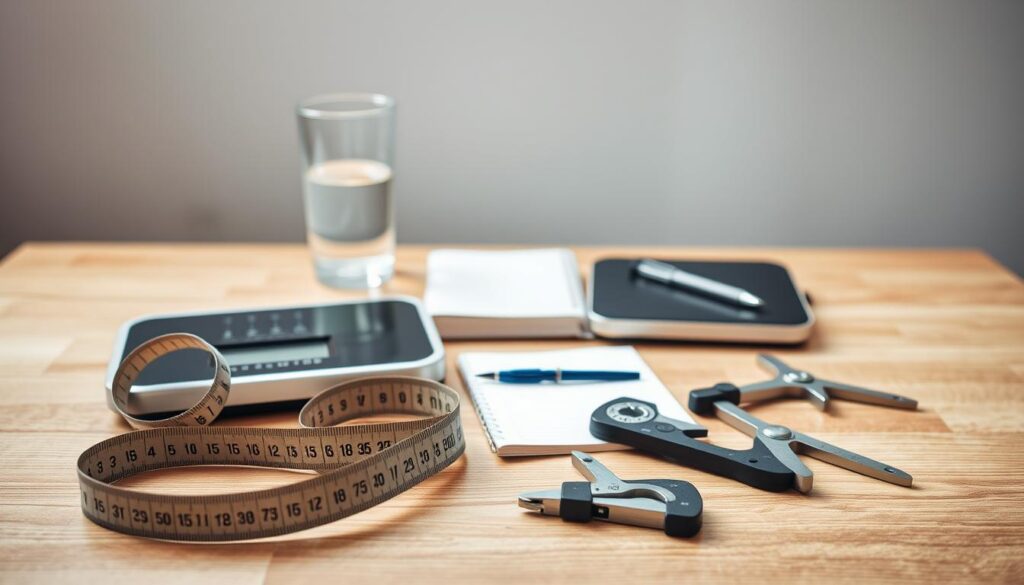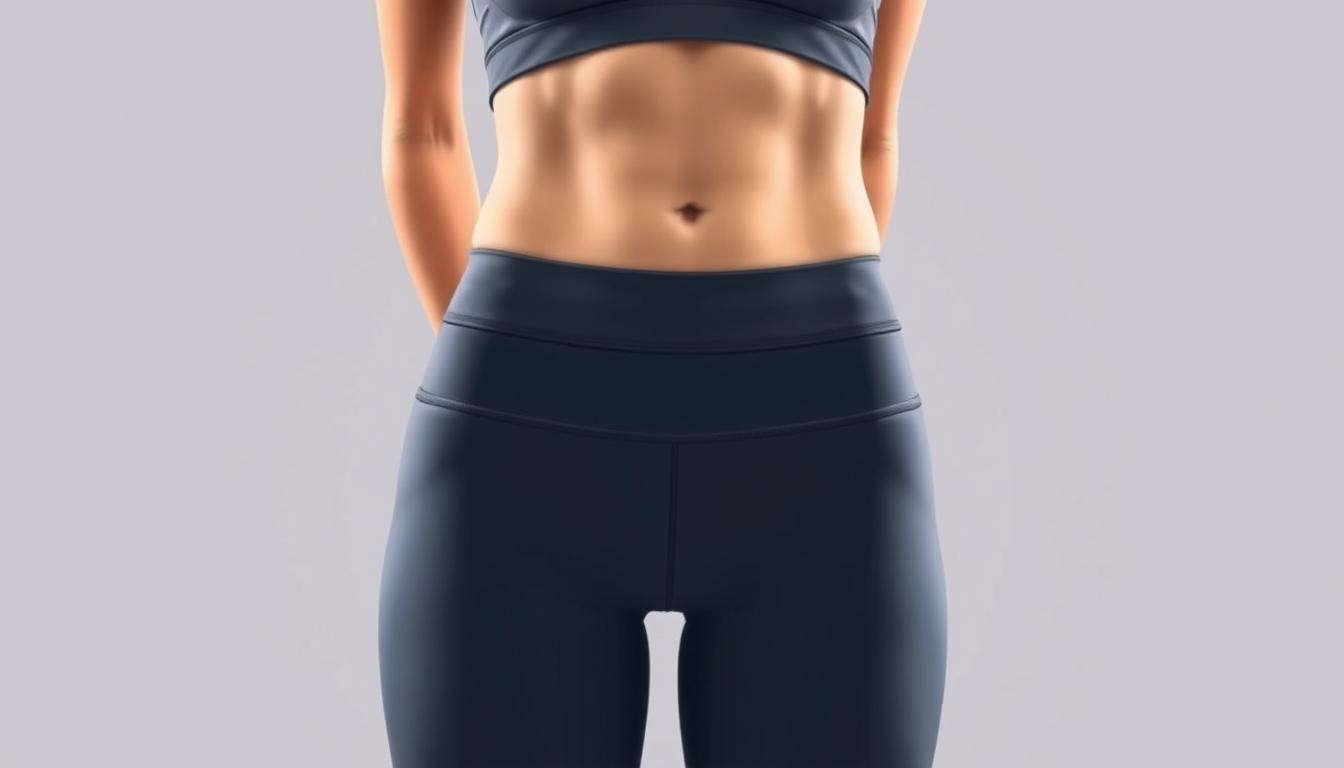Weight alone doesn’t reveal much about your fitness. What truly matters is understanding your body composition—specifically, your body fat percentage. This guide shows a straightforward way to gauge this metric using just a flexible measuring tape and a few minutes of your time.
We focus on waist measurements because they correlate closely with visceral fat—the type linked to health risks. Unlike stepping on a scale, this method highlights changes in fat distribution, even if your weight stays the same. All you need is a non-stretch tape and consistency in technique.
For best results, measure first thing in the morning before eating. Stand relaxed, and position the tape just above your hipbone. Record the number, and track trends over weeks—not daily fluctuations. Small adjustments here can reveal big insights about your progress.
Key Takeaways
- Waist size provides clues about visceral fat, which weight alone can’t show.
- A basic cloth tape works better than rigid tools for accurate readings.
- Morning measurements reduce variables like bloating for consistent tracking.
- Trends matter more than single numbers—track changes weekly.
- Pair this method with other metrics for a complete health picture.
Understanding Body Fat and Its Importance
Health risks often hide in fat distribution rather than total weight. While scales track pounds, they miss critical details about where fat accumulates. This gap makes understanding body fat percentage vital—it shows the proportion of fat versus lean mass in your physique.
What Is Body Fat Percentage?
This metric represents the amount of fat relative to your total weight. For example, a 20% reading means 20% of your body weight comes from fat. Unlike BMI, which only considers height and weight, this measurement accounts for muscle and bone density. Athletes often have lower percentages due to higher muscle mass.
Health Implications of Excess Fat
Carrying too much fat—especially around organs—increases risks for heart disease, diabetes, and high blood pressure. The American Council on Exercise (ACE) categorizes ranges like this:
| Fitness Level | Men | Women |
|---|---|---|
| Athletes | 6–24% | 16–30% |
| Fitness | 14–17% | 21–24% |
| Acceptable | 18–24% | 25–31% |
| Excess | 25%+ | 32%+ |
Regular measurements help spot trends. If your percentage creeps upward despite stable weight, it signals fat gain and muscle loss. Pair this data with waist size for a clearer health snapshot.
Preparing to Measure Body Fat at Home
Accurate tracking starts with reliable equipment. Gathering the right tools ensures your numbers reflect real changes rather than measurement errors. Let’s break down what you’ll need and why each item matters.

Your Measurement Toolkit
A non-stretch tape measure tops the list—cloth works better than metal for contouring to your shape. Look for one with clear markings and a sturdy clasp. Pair it with a digital scale that displays tenths of a pound for precise weight tracking.
Consistency matters most. Use the same tape and scale every time—morning readings before meals yield the most stable data. As fitness expert Dr. Ellen Cruz notes:
“Variations in tools or timing can skew results by up to 15%, masking true progress.”
Follow these guidelines for error-free measurements:
- Let the tape rest lightly against skin—no squeezing
- Stand naturally without sucking in your stomach
- Record three readings and average them
With these practices, you’ll create a trustworthy baseline. Small details—like how tightly you hold the tape—determine whether your numbers guide or mislead your health journey.
How to Estimate Body Fat from Waist Circumference
Tracking fitness progress goes beyond numbers on a scale. Waist size acts as a practical indicator of visceral fat—the type surrounding internal organs. Unlike expensive tools like DEXA scans, this approach requires only a flexible tape and proper technique.
Start by locating the top of your hip bone and the bottom of your ribcage. Position the tape midway between these points, aligning it with the umbilicus. Keep the tool parallel to the floor, ensuring it rests snugly without compressing skin.
Breathe normally during the process—no breath-holding or stomach tightening. Research from the National Institutes of Health confirms:
“Relaxed measurements taken at natural exhalation provide the most reliable data for longitudinal tracking.”
- Record three consecutive readings and calculate the average
- Conduct checks at the same time daily, ideally before breakfast
- Pair waist data with weight trends for comprehensive analysis
Online calculators use these metrics alongside height and age to approximate body fat percentage. While not as precise as clinical methods, this strategy offers a cost-effective way to monitor changes. Consistency in technique turns simple measurements into powerful health insights.
Step-by-Step Guide to Taking Waist Circumference Measurements
Mastering waist measurement technique transforms simple numbers into actionable health insights. Let’s break down the process to ensure your data reflects true progress—not measurement errors.

Correct Tape Measure Techniques
Follow this sequence for reliable results:
- Stand barefoot with feet shoulder-width apart
- Locate the midpoint between your lowest rib and hip bone
- Position the tape measure parallel to the floor
- Let the tape rest against skin without indentation
- Exhale normally before recording the number
The National Institutes of Health emphasizes:
“Even 1 cm of tape slippage can alter results by 2-3%, compromising trend analysis.”
Tips for Consistent and Accurate Results
Three strategies elevate your tracking:
- Use the same cloth tape for all measurements—metal types compress unevenly
- Measure before breakfast when bloating is minimal
- Have a partner verify tape alignment if self-measuring
For those new to calculating waist circumference, avoid these pitfalls:
- Pulling the tape too tight (creates false lows)
- Measuring over bulky clothing (adds artificial bulk)
- Holding breath during readings (distorts natural posture)
Track weekly averages rather than daily numbers. Small technique refinements yield big improvements in tracking visceral fat changes over time.
Exploring Alternative Methods to Measure Body Fat
While waist measurements offer valuable insights, other techniques can enhance your understanding of body composition. Tools like skinfold calipers and smart scales provide additional data points, helping you track changes with greater context.
Using Skinfold Calipers
This method involves pinching subcutaneous fat at specific sites—typically the triceps, abdomen, and thigh. A quality set of calipers measures the thickness of these folds, which formulas then convert into a body fat percentage. According to the American Council on Exercise:
“When performed by trained users, skinfold assessments can achieve 90-95% accuracy compared to clinical methods.”
Key tips for reliable results:
- Take measurements on dry, un-lotioned skin
- Use the same tester for repeated assessments
- Follow standardized anatomical landmarks
Other At-Home Measurement Approaches
Modern smart scales use bioelectrical impedance—sending safe electrical currents through the body. While convenient, hydration levels and meal timing can skew results by up to 5%. For higher precision, DEXA scans provide detailed fat distribution maps but require clinic visits and higher costs.
Consider these comparisons:
- Calipers: Low-cost but technique-sensitive
- Smart scales: Effortless but less precise
- DEXA: Gold standard but impractical for weekly checks
No single method tells the whole story. Pair waist tracking with occasional skinfold measurements or impedance readings. Consistent use of any approach reveals trends more clearly than sporadic high-tech tests.
Relating Waist Measurements to Overall Health
Your waistline tells a story that numbers on a scale can’t. Research shows abdominal size strongly predicts health risks—even when weight appears stable. We’ll explore how these measurements connect to vital organ systems and what your numbers mean.
Linking Waist Size with Health Risks
Excess abdominal fat acts like an active organ, releasing hormones that strain the heart and pancreas. The American Heart Association warns:
“Waist measurements above 35 inches (women) or 40 inches (men) increase diabetes risk by 300% compared to smaller sizes.”
Two ratios help assess danger levels:
| Ratio | High Risk (Women) | High Risk (Men) |
|---|---|---|
| Waist-to-Hip | 0.85+ | 0.90+ |
| Waist-to-Height | 0.53+ | 0.53+ |
Those exceeding these thresholds face elevated chances of:
- Coronary artery disease
- Insulin resistance
- Sleep apnea
Interpreting Your Results
Track three numbers—waist size, ratio scores, and body fat percentage. If two indicators fall into high-risk zones, consult a doctor. Even small reductions matter: Losing 1 inch from your waist lowers cardiovascular strain by 5-10%.
Remember these guidelines:
- Compare measurements to population averages for your age
- Note changes over 6-month periods, not weeks
- Combine waist data with blood pressure and cholesterol tests
While useful, these metrics don’t replace medical advice. Always discuss concerning patterns with your healthcare team.
Optimizing Your Measurement Process with Consistency
Reliable health tracking depends on eliminating variables that cloud your data. Using identical tools and conditions for each check turns raw numbers into trustworthy trends. This approach minimizes guesswork when evaluating lifestyle changes or exercise plans.
Tracking Progress Over Time
Establish a morning routine before eating or drinking. The CDC advises:
“Measurements taken under standardized conditions reduce errors by 22% compared to random checks.”
Three practices enhance accuracy:
- Store your cloth tape and scale in one accessible location
- Note clothing choices (e.g., lightweight shorts vs. jeans)
- Log results immediately in apps like MyFitnessPal
Weekly averages matter more than daily spikes. A 0.5-inch waist increase might reflect temporary bloating, while consistent upward trends over a month signal fat gain. Pair this data with weight logs to spot muscle-fat ratio shifts.
Expect natural fluctuations—hormones, hydration, and stress all influence readings. Focus on directional changes rather than fixating on single numbers. Consistent methods transform scattered data points into actionable health stories.
Conclusion
Understanding your physique requires multiple lenses—not just numbers on a tape. While waist checks offer a practical starting point, tools like DEXA scans and skinfold calipers provide deeper insights into muscle distribution and fat storage patterns. These methods work best when combined, especially for active individuals whose muscle mass might skew tape measurements.
Consistency remains key. Whether tracking weekly averages or comparing ratios over months, standardized practices reveal meaningful trends. Remember: health risks like diabetes correlate more strongly with abdominal fat than total weight. Women and men should consider their unique biological factors when interpreting results.
Use this guide as a foundation—not a final verdict. Pair tape readings with occasional clinical tests or bioelectrical impedance checks for balanced perspectives. Share your progress, revisit these strategies, and celebrate incremental improvements. True wellness lies in connecting dots between measurements, habits, and how you feel daily.


